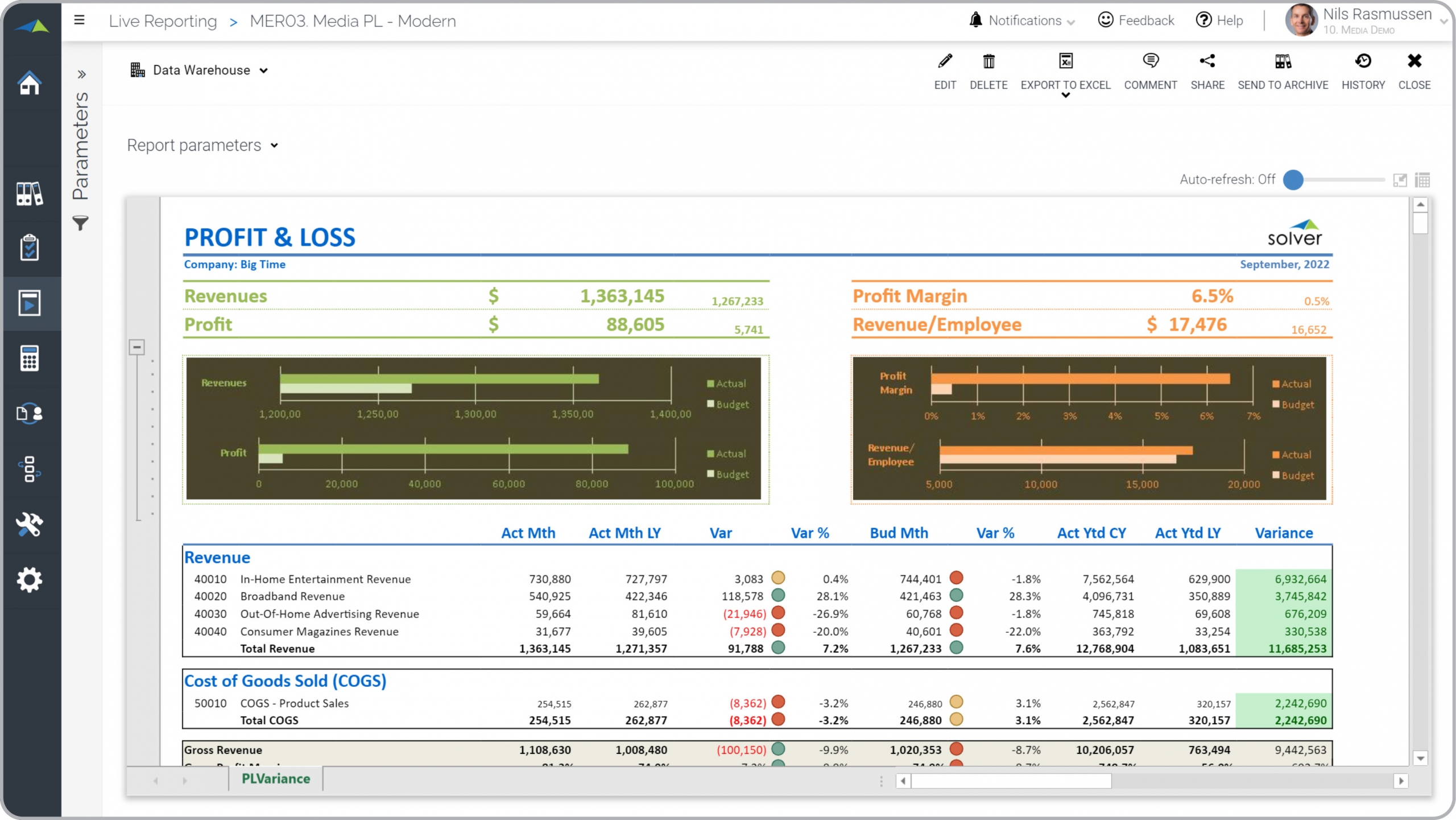Profit & Loss Variance Report for Media Companies
What is
a
Profit & Loss Variance Report for Media Companies
? Profit & Loss Variance Reports are considered monthly analysis tools and are used by executives and financial leaders to review profit margins and variances. Some of the main functionality in this type of report is that it is combines charts and a typical P&L layout with dynamic rows that automatically includes new general ledger (GL) accounts. The charts highlight KPIs for Revenues, Profit, Profit Margin, and Revenue per Employee. The detailed figures include: Actuals for the month, Actuals for the same month last year, Variance, Variance in percent, Budget for the current month with variances, Actual year-to-date (YTD) current year, and Actual year-to-date (YTD) prior year with variances. You find an example of this type of report below.
Purpose of
Profit & Loss Variance Reports Media companies use Profit & Loss Variance Reports to give managers a clear financial picture of the business and in an easily readable format. When used as part of good business practices in Executive and Financial Planning & Analysis (FP&A) departments, a company can improve its decision-making and grow related revenues, and it can reduce the chances that managers miss the "story" behind the numbers.
Example of a
Profit & Loss Variance Report Here is an example of a Profit & Loss Report with charts, traffic light indicators and a modern layout. [caption id="" align="alignnone" width="2560"]
 Example of a Profit & Loss Variance Report for Media Companies[/caption] You can find hundreds of additional examples
here
Who Uses This Type of
Report
? The typical users of this type of report are: Board Members, CEOs and other executives, Financial Managers.
Other Reports Often Used in Conjunction with
Profit & Loss Reports Progressive Executive and Financial Planning & Analysis (FP&A) departments sometimes use several different Profit & Loss Reports, along with balance sheets, cash flow statements, profit & loss budgets, annual budgets, financial dashboards, KPI dashboards and other management and control tools.
Where Does the Data for Analysis Originate From? The Actual (historical transactions) data typically comes from enterprise resource planning (ERP) systems like: Microsoft Dynamics 365 (D365) Finance, Microsoft Dynamics 365 Business Central (D365 BC), Microsoft Dynamics AX, Microsoft Dynamics NAV, Microsoft Dynamics GP, Microsoft Dynamics SL, Sage Intacct, Sage 100, Sage 300, Sage 500, Sage X3, SAP Business One, SAP ByDesign, Acumatica, Netsuite and others. In analyses where budgets or forecasts are used, the planning data most often originates from in-house Excel spreadsheet models or from professional corporate performance management (CPM/EPM) solutions.
What Tools are Typically used for Reporting, Planning and Dashboards? Examples of business software used with the data and ERPs mentioned above are:
Example of a Profit & Loss Variance Report for Media Companies[/caption] You can find hundreds of additional examples
here
Who Uses This Type of
Report
? The typical users of this type of report are: Board Members, CEOs and other executives, Financial Managers.
Other Reports Often Used in Conjunction with
Profit & Loss Reports Progressive Executive and Financial Planning & Analysis (FP&A) departments sometimes use several different Profit & Loss Reports, along with balance sheets, cash flow statements, profit & loss budgets, annual budgets, financial dashboards, KPI dashboards and other management and control tools.
Where Does the Data for Analysis Originate From? The Actual (historical transactions) data typically comes from enterprise resource planning (ERP) systems like: Microsoft Dynamics 365 (D365) Finance, Microsoft Dynamics 365 Business Central (D365 BC), Microsoft Dynamics AX, Microsoft Dynamics NAV, Microsoft Dynamics GP, Microsoft Dynamics SL, Sage Intacct, Sage 100, Sage 300, Sage 500, Sage X3, SAP Business One, SAP ByDesign, Acumatica, Netsuite and others. In analyses where budgets or forecasts are used, the planning data most often originates from in-house Excel spreadsheet models or from professional corporate performance management (CPM/EPM) solutions.
What Tools are Typically used for Reporting, Planning and Dashboards? Examples of business software used with the data and ERPs mentioned above are:
- Native ERP report writers and query tools
- Spreadsheets (for example Microsoft Excel)
- Corporate Performance Management (CPM) tools (for example Solver)
- Dashboards (for example Microsoft Power BI and Tableau)
Corporate Performance Management (CPM) Cloud Solutions and More Examples
July 21, 2021
TAGS:
Reporting,
Solver,
print,
report writer,
Microsoft,
template,
practice,
Acumatica,
Netsuite,
TV,
streaming,
Finance,
planning,
GP,
category,
profit & loss,
Business Central,
excel,
radio,
ax,
income statement,
forecast,
Budget,
Dynamics 365,
sales forecast,
budgeting,
Cloud,
Software,
Tableau,
SAP,
example,
media,
best,
Sage,
BC,
D365,
NAV,
Intacct,
broadcast,
brand,
online,
CPM,
report,
SL,
Management,
dynamics,
sales budget,
Power BI,
P&L variance report

